Kiev coup. City, where power changed 14 times, from 1917 to 1920
 Bashny.Net
Bashny.Net
Today we will talk about the unique period, nothing like that in the history of Kiev did not have before, and - we hope! - Not going to happen in the future.
Thirty nine months, from March 1917 to June 1920, the power in the city changed fourteen times.
Some of the then Kiev was almost bloodless coups, while others - cost the lives of considerable number of people of Kiev ...
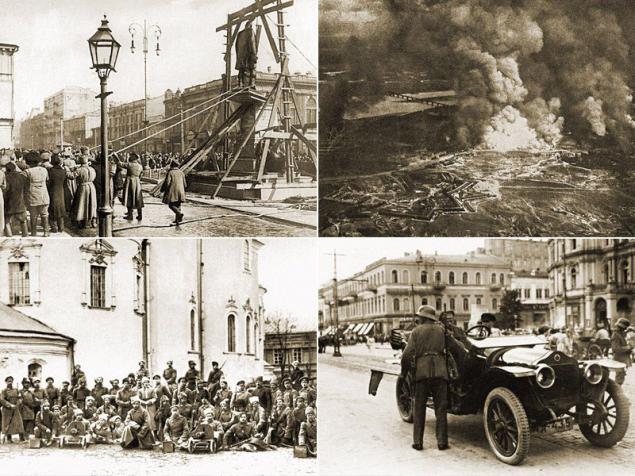
The interim government. 2 (15) of March - 7 (20) November 1917
The news of the fall of three hundred years of the Romanov dynasty in Kiev is not reached immediately. In our city, at first everything was calmer than in St. Petersburg - but after learning about the changes (they herald for Kiev became a deputy of the State Duma Alexander bagels, famed Mikhail Bulgakov sent out a telegram which began with the words "The old regime fell"), took to the streets of Kiev. The word "freedom" was in the air, though, perhaps, a few at a time to understand exactly what is behind it, and that very few people knew how it would end ...
(One of the first demonstrations on Khreshchatyk during the February Revolution. On the left in the background - the Duma Square (now Independence Square). 1917 / Publisher Wart)

Symbolic personification of the fallen regime for many people of Kiev was put on the main square of the city in less than five years before the monument to Peter Stolypin - the king's prime minister, killed by terrorists in Kiev in 1911. It is not surprising that this monument was subjected to, figuratively speaking, hanging in the first weeks of the revolution. Training lasted for two days and on the third day the statue was thrown from its pedestal.
(Removal of the monument to Stolypin Duma area. 17 (30) March 1917 / Publisher Wart) is a bit like ...
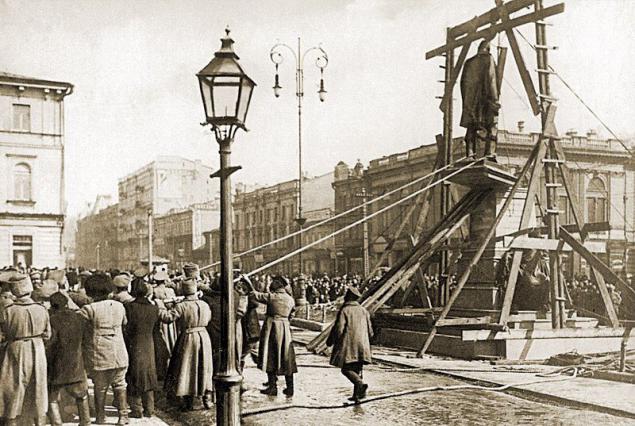
Central Rada. 7 (20) November 1917 - January 26 (February 8), 1918
Central Council - the future of Ukrainian parliament (though unelected) was formed in the early days of the revolution. Its Chairman was elected Hrushevsky. In the summer and autumn of 1917 gradually increased the role of Parliament. When, in late October, authorities in the capital of the former empire, the Bolsheviks seized in Kiev formed three camps: 1) the troops of the Kiev military district (already supported the deposed Provisional Government); 2) the same Bolsheviks; 3) Ukrainian forces rallied around the Central Rada. A few days in the city was "triangular battle" - each of the parties at war against the other two. The winner left the Central Rada. Publishes its 7 (20) November 1917 III-th was proclaimed Universal of Ukrainian People's Republic (though not as an independent state, but as a part of Russia).
(Meeting at the Sofia area. In the center - Simon Petlyura, Vladimir Vinnichenko, Hrushevsky. October 1917 / Publisher Wart)
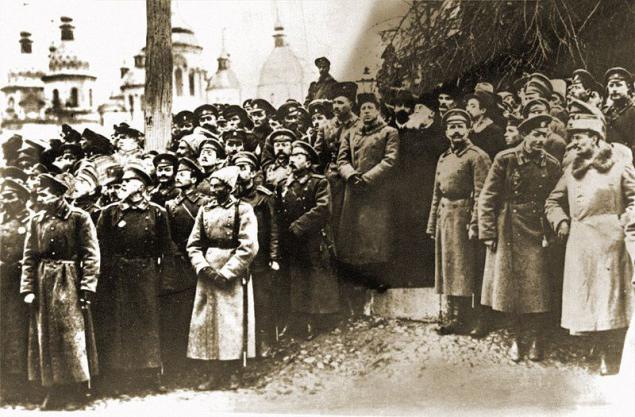
9 (22) January 1918 IV-th Universal of the Central Rada proclaimed the independence of Ukraine. The Bolsheviks, however, did not stop the fight. In the second half of January they organized in Kiev, an armed rebellion against the Central Rada (went down in history as the January Uprising). The uprising was crushed - but a few days later the army under the command of the Bolshevik Mikhail Muravyov attack from the east took Kiev.
(Demonstration on the occasion of the proclamation of the III-rd Universal of the Central Rada. 1917 / Publisher Wart)
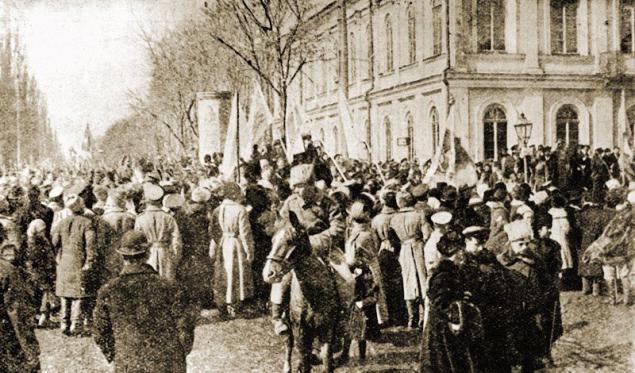
The Bolsheviks. January 26 (February 8) - March 1, 1918
The arrival of the Bolsheviks in the city has been marked by a large number of victims (estimated then was shot several thousand people, representing a danger to the new government, with its point of view). However, the Bolsheviks heroes of his supporters who were killed during the events of January.
The first Bolshevik government in Kiev, lasted just over a month. Central Rada, who had to evacuate from Kiev to sign the Brest peace treaty with Germany and Austria-Hungary, requested military assistance from new allies. Bolsheviks easily pushed superior military force.
(Funeral participants of the January Uprising in Kiev. February 17, 1918)
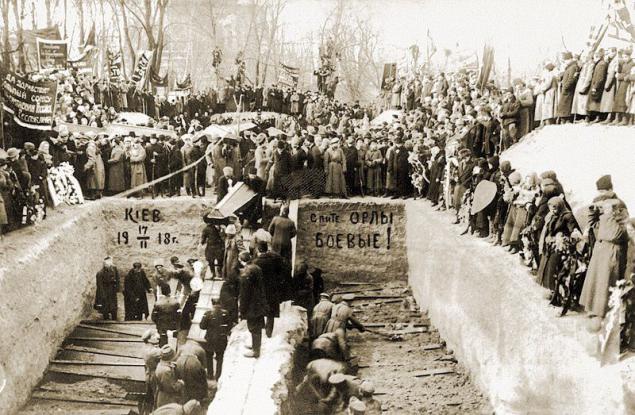
Central Rada. March 1 - April 29, 1918
Together with the Germans returned to the city of the Ukrainian army - and the Central Council.
As nominal power in Kiev and Ukraine, the Central Council, however, in reality poorly controlled the situation even in the capital. She did not enjoy authority among the masses and has no real power. The actual masters of the situation were the Germans who are interested in Ukraine, first of all, economically (they needed bread!) And allow themselves, in modern terms, a gross interference in the internal affairs of an independent state. The Germans made laws and orders as are deemed necessary and required by the Ukrainians of their strict compliance.
(Troops of the Central Rada from St. Michael's Cathedral. 1918)
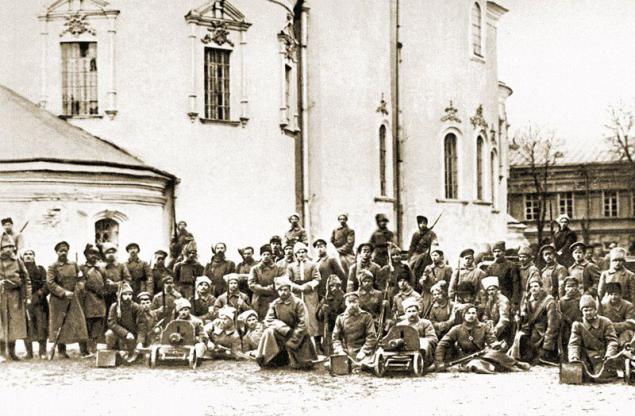
The second power of the Central Rada lasted less than two months and ended with the German "guests" home tired ... The formal reason for the dissolution of Parliament was the arrest of the banker Abraham the good that the Germans declared illegal, opened its investigation - and on April 28 in the meeting room of the Ukrainian parliament came German lieutenant and commanded "Hands up!". Obeys all but the presiding Hrushevsky ...
(Changing of the guard in front of the German thought at the Duma area. 1918)

Getman. April 29 - December 14, 1918
The next day, April 29, the Central Council gathered for its last meeting - but on the same day at the circus Krutikova on Nikolaev street (now the street Gorodetsky) held a so-called "Congress of farmers", which elected a new ruler of Ukraine with the old title of Hetman - Paul Skoropadsky.
In fact, there was a classic coup. UPR was renamed the Ukrainian State. However, the real power in the new state largely remained in those who had the real power - the Germans.
(Hetman Pavlo Skoropadsky with congress delegates hleborobov.1918 year)
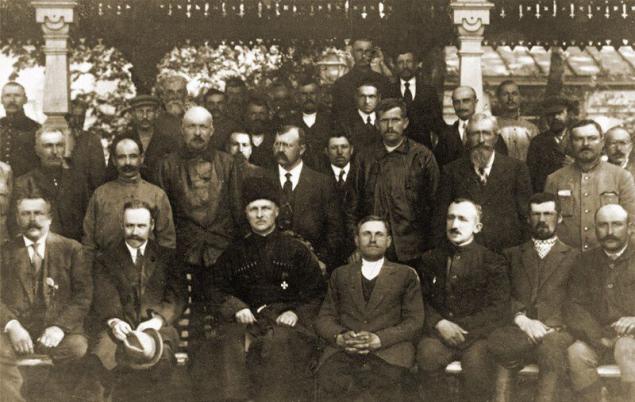
(Meeting at the Kiev railway station in-Chief Army Group "Kiev" Field Marshal Hermann von Eichhorn. April 1918)

(German military band in front of the City Council. May 1918)

All the people of Kiev, who left vague memories of this time are unanimous in their impressions: the highest order was "the Germans." It was safe to walk the streets, appeared in stores goods, restaurants and theaters were full of audience ... Kiev, among other things, was crowded with refugees from Moscow and St. Petersburg, which lives under the Bolsheviks did not suit. There were, however, in Kiev and the events are not typical in peacetime. June 6, 1918 there was a huge explosion of force artillery depots in Zverinets practically erased from the face of the earth a part of the city. This was a tragic accident or sabotage, for sure never revealed.
(The explosion of artillery depots and start a fire in the menagerie. June 6, 1918)
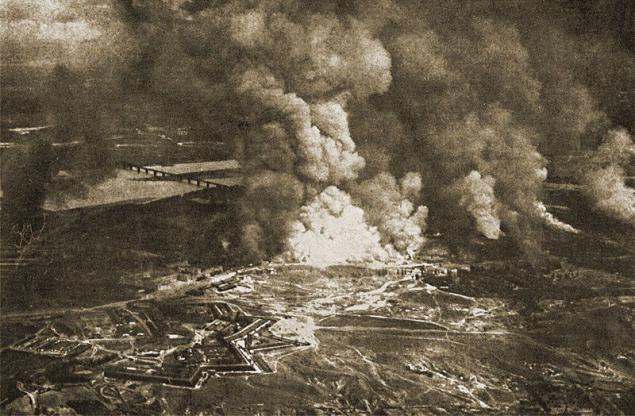
July 30 in the heart of Kiev, Nikolaev street, was killed by a bomb Hermann von Eichhorn. Suicide - SR Boris Don - was caught in the act and soon executed. Germans "tighten the screws" and illusions about who runs the affairs of the state, has become even less.
When November 11 Germans surrendered in World War II, it became clear that the Ukrainian State will have is not easy. Dissatisfied hetman power and before that was enough. A few days later the organization was founded, named for the French revolutionary style - Directory - antigetmanskoe and lead the uprising. The troops of the Directory headed by Simon Petlyura quickly came to Kiev, which, as it turned out, few people wanted to protect. City held only as long as it was in the interests of the Germans (who wanted to quietly withdraw from the Ukraine). December 14, 1918 the hetman abdicated and went to Kiev Petlyura troops. That these events said Mikhail Bulgakov in "The White Guard» ...
(Tight security after the murder of Field Marshal Eichhorn. Examination of documents on Khreshchatyk)
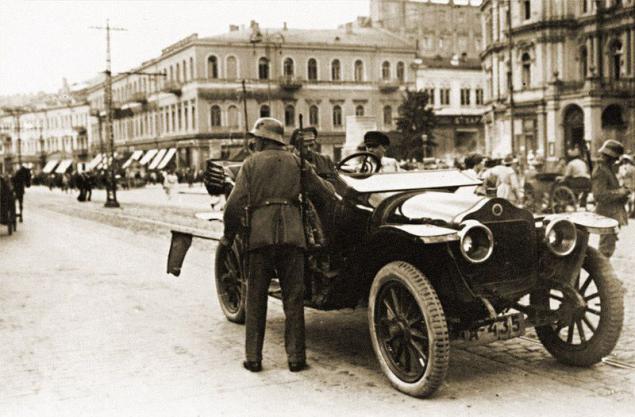
Directory. December 14, 1918 - February 5, 1919
One of the first actions of the Directory in Kiev, townspeople well remember, consisted of a total replacement, within three days, all Russian Ukrainian signage and labels (signs in Polish and Hebrew did not touch). However, the most significant event of the period was the announcement of the Universal Directory of catholicity of Ukraine - that is, the merger reduced the UPR and the resulting fall of 1918 ZUNR (West Ukrainian People's Republic). Event Date - January 22, 1919 - was dedicated to the first anniversary of the independence of the UPR.
(A solemn meeting of directors of the Kiev railway station. December 19, 1918)
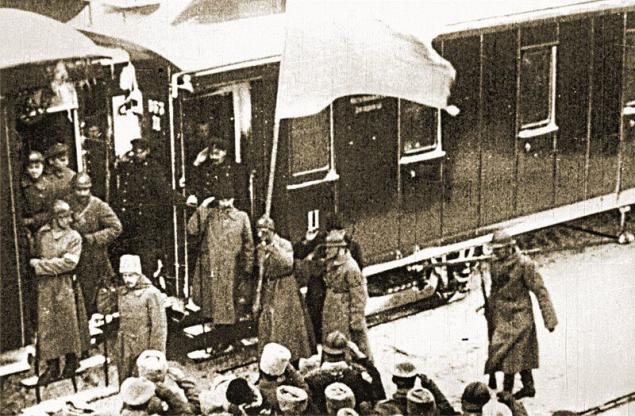
However, according to the direct participants in the events, collegiality remained essentially declarative event. The contradictions between the two parts of the Ukraine were significant and real unification does not happen. Directory as soon dislodged from Kiev - held the second coming of the Bolsheviks ...
(Ceremonial announcement at the Sofia area Universal catholicity of Ukraine. January 22, 1919)

The Bolsheviks. February 5 - August 30, 1919
True to the principle of "We are ours, we construct a new world", the Bolsheviks set about breaking up the old energetic. Demolition of the royal monuments, and those that could not immediately carry - draped so as not an eyesore. Instead, they were placed hastily erected - sometimes made of plywood! - New. May Day became an official holiday. People are accustomed to live and think in a revolutionary way. Dissent or even suspected of disagreement could punish; This is ensured by Extraordinary Commission (Cheka).
(Entry Bolshevik troops in Kyiv. February 5, 1919)

Action generates a reaction. In April 1919, Ataman Struk raised in Kiev uprising, in which the Bolsheviks almost kicked out of the city. By late summer, the position of the Soviet government in Kiev has become threatening. In a city with two sides were approaching opponents of the Bolsheviks: the south-west - the army under the command of the UPR Petliura, from the east - Whites (Poltava detachment of the Volunteer Army of Denikin) under the command of General Bredow.

UPR. August 30 - August 31, 1919
The upshot was that the government has changed twice in two days. Ukrainians went to Kiev on the day before the Whites, but not taken care of, to how to gain a foothold in the city. The next day, August 31, 1919 a meeting of the warring parties directly in the center of Kiev, on the Duma area (held nearly a hundred years, and almost at the same place again begin showdown ...)
While the Whites were in the minority, they won.
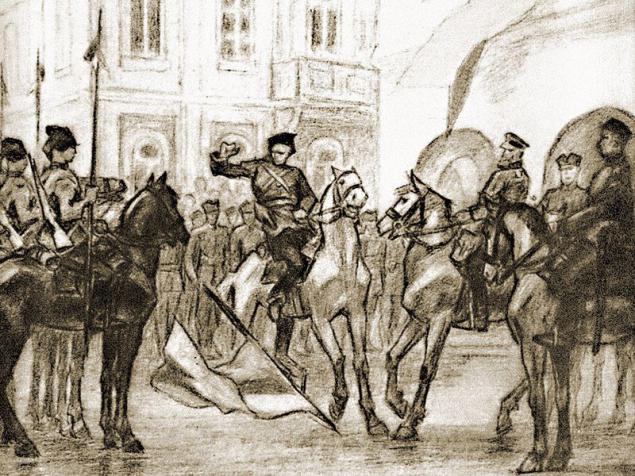
Volunteer Army. August 31 - October 14, 1919
Arriving in Kiev, the Whites tried to put the clock back - figuratively and literally. Calendar transferred to the old-style (ie, thirteen days ago), the clock - on the Petrograd time. All the laws of the Soviet government, and along with his money, were canceled. But the main advocacy event of the new government was exposing the activities of the Cheka. As happens in such cases, it sometimes resulted in lynching suspected of Bolshevism - in the streets.
(The leaders of the Volunteer Army in Kiev: General May-Majewski (first from left), General Bredow (second from left). 1919)
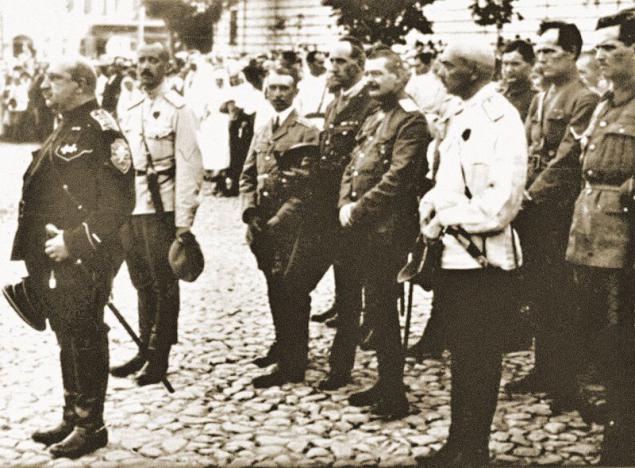
Although the official policy of the white leaders, headed by Denikin was "nepredreshenie" (to be Russian monarchy, a republic or something else were to decide they did not, and the Constituent Assembly), the musicians began to force Kiev restaurants play "God Save the Tsar." Someone liked it, someone - not really.
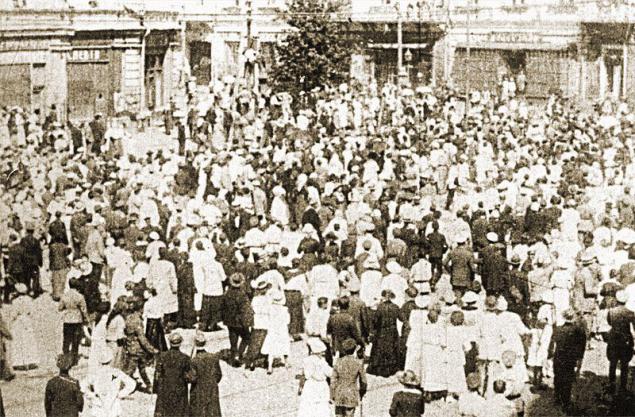
The Bolsheviks. October 14 - October 16, 1919
While the Whites set new-old order, the Bolsheviks were preparing to take revenge. October 14, 1919 they succeeded. A sudden attack from the west, the Bolsheviks seized the town, forcing the Whites immediately retreat of the Dnieper, the left bank. Along with them tens of thousands of residents have left, do not expect anything good return Bolsheviks.
This exodus called "Darnitskiy outcome." He continues, however, for long. On the third day of the Volunteer Army crossed the Kiev bridges in the opposite direction of Darnitsa on the right bank, and drove the Bolsheviks in Kiev.
Volunteer Army. October 16 - December 16, 1919
When he returned, the Whites began, as so often happens, look for the guilty. Those quickly found in the person of Kiev Jews who supposedly sympathetic to the Bolsheviks, and by backing the Volunteer Army allegedly fired from the windows. Staged a "silent massacre" - in modern terms, however, it is more like a simple racket: to the Jews demanded "financial aid." However, the case of the Volunteer Army went from bad to worse. Closer to winter, it became clear that Kiev does not hold. Those who did not wait for the mercy of the Bolsheviks again left Kiev - is no longer heading in Darnitsa, and in Odessa and Crimea - that, for the most part, it does not ever come back.
December 16, 1919, the Bolsheviks entered the fourth time in Kiev - as in February of the same year, almost without a fight.
The Bolsheviks. December 16, 1919 - May 7, 1920
"Where are your flowers ?! - Shouted the people of Kiev Red Army entering the city. - White Guards you !! their trays. " But unlike the previous coming, this time the Bolsheviks their opponents hardly repressed. Instead, they started to build a measured relative mode. This was followed by the construction of the terrible mud, lack of food and the flourishing of bureaucracy. Activities Bolshevik parties not overnight, gradually but folded. The result is held in April, furnished big celebrations in the city council elections was practically "right": about 75% of the Communists. As of May was dedicated communist Saturday.
But less than a week after the feast of the proletariat of Kiev, the Bolsheviks were forced to once again rushed to pack their suitcases. The city approached the "guests" until it has been honored with a visit - the Poles.
Poles. May 7 - June 12, 1920
The Polish army entered the city without a fight. Patrol Polish volunteers traveled from the Forest-Vodice center - take a city! - ... On the shuttle tram. The next day at Khreshchatyk was organized a big parade.
(Polish and Ukrainian troops at Khreshchatyk. May 8, 1920)

Together with the Poles in the Ukrainian army entered the city. Nominally at Kiev now again extended the power of the Directory of the UNR. In fact, this did not happen. The government, made up late and did not have time to move from Vinnitsa to Kiev. The head of the Directory, the same Simon Petlyura, arrived in the capital with a visit which was followed by celebrations at the Sofia area and in the same cathedral - but immediately afterwards departed.
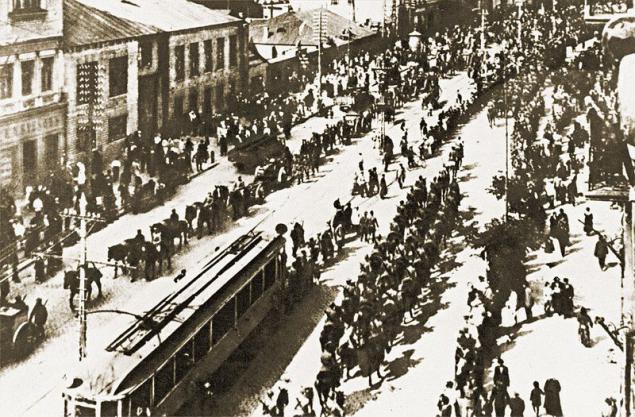
The Poles, of course, the people of Kiev were perceived as the invaders. But if the Germans two years ago were able to ensure order and peace townspeople, now life was disorganized. As before, there was no money, food, essential commodities ... stay in Kiev, the Poles could only by sufficient military strength - but they did not have it.
The Bolsheviks. June 12, 1920 - ...
Under pressure from the advancing Red Army Poles left Kiev organized, but the people of Kiev did some very unpleasant "gifts" goodbye. They blew up and burned down all four of the bridge over the Dnieper, the governor-general's palace on the Limes, the railway freight station.

Because one of the first slogans of the Bolsheviks returned to the city has become "the restoration of the bridge!". Residents continued to teach to the fact that their whole life will now be subject to the "interests of the people" - but what exactly are these interests, define power. Private enterprises, excluding small handicraft shops, were nationalized. Life has become within the jurisdiction of the Soviet institutions. Because economic prosperity it has not brought the products sold on the cards (to be fair: the first ration cards appeared in Kiev significantly before the Bolsheviks came to power - in 1916).
Gradually, however, life returned to relatively normal. Fighting in the city was no more. Part of the new regime have left dissatisfied, and the rest - were reconciled. Ahead of seven decades of Soviet rule ...
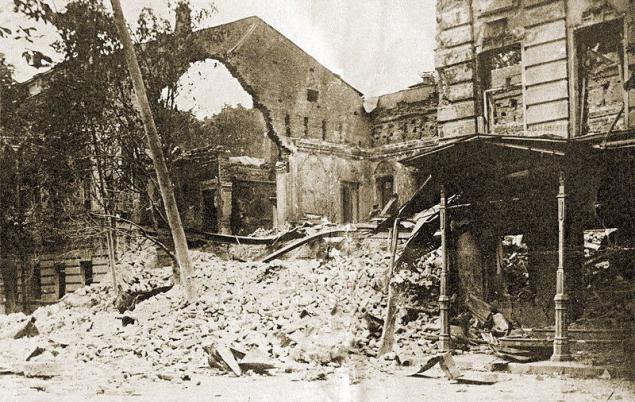
Thirty nine months, from March 1917 to June 1920, the power in the city changed fourteen times.
Some of the then Kiev was almost bloodless coups, while others - cost the lives of considerable number of people of Kiev ...

The interim government. 2 (15) of March - 7 (20) November 1917
The news of the fall of three hundred years of the Romanov dynasty in Kiev is not reached immediately. In our city, at first everything was calmer than in St. Petersburg - but after learning about the changes (they herald for Kiev became a deputy of the State Duma Alexander bagels, famed Mikhail Bulgakov sent out a telegram which began with the words "The old regime fell"), took to the streets of Kiev. The word "freedom" was in the air, though, perhaps, a few at a time to understand exactly what is behind it, and that very few people knew how it would end ...
(One of the first demonstrations on Khreshchatyk during the February Revolution. On the left in the background - the Duma Square (now Independence Square). 1917 / Publisher Wart)

Symbolic personification of the fallen regime for many people of Kiev was put on the main square of the city in less than five years before the monument to Peter Stolypin - the king's prime minister, killed by terrorists in Kiev in 1911. It is not surprising that this monument was subjected to, figuratively speaking, hanging in the first weeks of the revolution. Training lasted for two days and on the third day the statue was thrown from its pedestal.
(Removal of the monument to Stolypin Duma area. 17 (30) March 1917 / Publisher Wart) is a bit like ...

Central Rada. 7 (20) November 1917 - January 26 (February 8), 1918
Central Council - the future of Ukrainian parliament (though unelected) was formed in the early days of the revolution. Its Chairman was elected Hrushevsky. In the summer and autumn of 1917 gradually increased the role of Parliament. When, in late October, authorities in the capital of the former empire, the Bolsheviks seized in Kiev formed three camps: 1) the troops of the Kiev military district (already supported the deposed Provisional Government); 2) the same Bolsheviks; 3) Ukrainian forces rallied around the Central Rada. A few days in the city was "triangular battle" - each of the parties at war against the other two. The winner left the Central Rada. Publishes its 7 (20) November 1917 III-th was proclaimed Universal of Ukrainian People's Republic (though not as an independent state, but as a part of Russia).
(Meeting at the Sofia area. In the center - Simon Petlyura, Vladimir Vinnichenko, Hrushevsky. October 1917 / Publisher Wart)

9 (22) January 1918 IV-th Universal of the Central Rada proclaimed the independence of Ukraine. The Bolsheviks, however, did not stop the fight. In the second half of January they organized in Kiev, an armed rebellion against the Central Rada (went down in history as the January Uprising). The uprising was crushed - but a few days later the army under the command of the Bolshevik Mikhail Muravyov attack from the east took Kiev.
(Demonstration on the occasion of the proclamation of the III-rd Universal of the Central Rada. 1917 / Publisher Wart)

The Bolsheviks. January 26 (February 8) - March 1, 1918
The arrival of the Bolsheviks in the city has been marked by a large number of victims (estimated then was shot several thousand people, representing a danger to the new government, with its point of view). However, the Bolsheviks heroes of his supporters who were killed during the events of January.
The first Bolshevik government in Kiev, lasted just over a month. Central Rada, who had to evacuate from Kiev to sign the Brest peace treaty with Germany and Austria-Hungary, requested military assistance from new allies. Bolsheviks easily pushed superior military force.
(Funeral participants of the January Uprising in Kiev. February 17, 1918)

Central Rada. March 1 - April 29, 1918
Together with the Germans returned to the city of the Ukrainian army - and the Central Council.
As nominal power in Kiev and Ukraine, the Central Council, however, in reality poorly controlled the situation even in the capital. She did not enjoy authority among the masses and has no real power. The actual masters of the situation were the Germans who are interested in Ukraine, first of all, economically (they needed bread!) And allow themselves, in modern terms, a gross interference in the internal affairs of an independent state. The Germans made laws and orders as are deemed necessary and required by the Ukrainians of their strict compliance.
(Troops of the Central Rada from St. Michael's Cathedral. 1918)

The second power of the Central Rada lasted less than two months and ended with the German "guests" home tired ... The formal reason for the dissolution of Parliament was the arrest of the banker Abraham the good that the Germans declared illegal, opened its investigation - and on April 28 in the meeting room of the Ukrainian parliament came German lieutenant and commanded "Hands up!". Obeys all but the presiding Hrushevsky ...
(Changing of the guard in front of the German thought at the Duma area. 1918)

Getman. April 29 - December 14, 1918
The next day, April 29, the Central Council gathered for its last meeting - but on the same day at the circus Krutikova on Nikolaev street (now the street Gorodetsky) held a so-called "Congress of farmers", which elected a new ruler of Ukraine with the old title of Hetman - Paul Skoropadsky.
In fact, there was a classic coup. UPR was renamed the Ukrainian State. However, the real power in the new state largely remained in those who had the real power - the Germans.
(Hetman Pavlo Skoropadsky with congress delegates hleborobov.1918 year)

(Meeting at the Kiev railway station in-Chief Army Group "Kiev" Field Marshal Hermann von Eichhorn. April 1918)

(German military band in front of the City Council. May 1918)

All the people of Kiev, who left vague memories of this time are unanimous in their impressions: the highest order was "the Germans." It was safe to walk the streets, appeared in stores goods, restaurants and theaters were full of audience ... Kiev, among other things, was crowded with refugees from Moscow and St. Petersburg, which lives under the Bolsheviks did not suit. There were, however, in Kiev and the events are not typical in peacetime. June 6, 1918 there was a huge explosion of force artillery depots in Zverinets practically erased from the face of the earth a part of the city. This was a tragic accident or sabotage, for sure never revealed.
(The explosion of artillery depots and start a fire in the menagerie. June 6, 1918)

July 30 in the heart of Kiev, Nikolaev street, was killed by a bomb Hermann von Eichhorn. Suicide - SR Boris Don - was caught in the act and soon executed. Germans "tighten the screws" and illusions about who runs the affairs of the state, has become even less.
When November 11 Germans surrendered in World War II, it became clear that the Ukrainian State will have is not easy. Dissatisfied hetman power and before that was enough. A few days later the organization was founded, named for the French revolutionary style - Directory - antigetmanskoe and lead the uprising. The troops of the Directory headed by Simon Petlyura quickly came to Kiev, which, as it turned out, few people wanted to protect. City held only as long as it was in the interests of the Germans (who wanted to quietly withdraw from the Ukraine). December 14, 1918 the hetman abdicated and went to Kiev Petlyura troops. That these events said Mikhail Bulgakov in "The White Guard» ...
(Tight security after the murder of Field Marshal Eichhorn. Examination of documents on Khreshchatyk)

Directory. December 14, 1918 - February 5, 1919
One of the first actions of the Directory in Kiev, townspeople well remember, consisted of a total replacement, within three days, all Russian Ukrainian signage and labels (signs in Polish and Hebrew did not touch). However, the most significant event of the period was the announcement of the Universal Directory of catholicity of Ukraine - that is, the merger reduced the UPR and the resulting fall of 1918 ZUNR (West Ukrainian People's Republic). Event Date - January 22, 1919 - was dedicated to the first anniversary of the independence of the UPR.
(A solemn meeting of directors of the Kiev railway station. December 19, 1918)

However, according to the direct participants in the events, collegiality remained essentially declarative event. The contradictions between the two parts of the Ukraine were significant and real unification does not happen. Directory as soon dislodged from Kiev - held the second coming of the Bolsheviks ...
(Ceremonial announcement at the Sofia area Universal catholicity of Ukraine. January 22, 1919)

The Bolsheviks. February 5 - August 30, 1919
True to the principle of "We are ours, we construct a new world", the Bolsheviks set about breaking up the old energetic. Demolition of the royal monuments, and those that could not immediately carry - draped so as not an eyesore. Instead, they were placed hastily erected - sometimes made of plywood! - New. May Day became an official holiday. People are accustomed to live and think in a revolutionary way. Dissent or even suspected of disagreement could punish; This is ensured by Extraordinary Commission (Cheka).
(Entry Bolshevik troops in Kyiv. February 5, 1919)

Action generates a reaction. In April 1919, Ataman Struk raised in Kiev uprising, in which the Bolsheviks almost kicked out of the city. By late summer, the position of the Soviet government in Kiev has become threatening. In a city with two sides were approaching opponents of the Bolsheviks: the south-west - the army under the command of the UPR Petliura, from the east - Whites (Poltava detachment of the Volunteer Army of Denikin) under the command of General Bredow.

UPR. August 30 - August 31, 1919
The upshot was that the government has changed twice in two days. Ukrainians went to Kiev on the day before the Whites, but not taken care of, to how to gain a foothold in the city. The next day, August 31, 1919 a meeting of the warring parties directly in the center of Kiev, on the Duma area (held nearly a hundred years, and almost at the same place again begin showdown ...)
While the Whites were in the minority, they won.

Volunteer Army. August 31 - October 14, 1919
Arriving in Kiev, the Whites tried to put the clock back - figuratively and literally. Calendar transferred to the old-style (ie, thirteen days ago), the clock - on the Petrograd time. All the laws of the Soviet government, and along with his money, were canceled. But the main advocacy event of the new government was exposing the activities of the Cheka. As happens in such cases, it sometimes resulted in lynching suspected of Bolshevism - in the streets.
(The leaders of the Volunteer Army in Kiev: General May-Majewski (first from left), General Bredow (second from left). 1919)

Although the official policy of the white leaders, headed by Denikin was "nepredreshenie" (to be Russian monarchy, a republic or something else were to decide they did not, and the Constituent Assembly), the musicians began to force Kiev restaurants play "God Save the Tsar." Someone liked it, someone - not really.

The Bolsheviks. October 14 - October 16, 1919
While the Whites set new-old order, the Bolsheviks were preparing to take revenge. October 14, 1919 they succeeded. A sudden attack from the west, the Bolsheviks seized the town, forcing the Whites immediately retreat of the Dnieper, the left bank. Along with them tens of thousands of residents have left, do not expect anything good return Bolsheviks.
This exodus called "Darnitskiy outcome." He continues, however, for long. On the third day of the Volunteer Army crossed the Kiev bridges in the opposite direction of Darnitsa on the right bank, and drove the Bolsheviks in Kiev.
Volunteer Army. October 16 - December 16, 1919
When he returned, the Whites began, as so often happens, look for the guilty. Those quickly found in the person of Kiev Jews who supposedly sympathetic to the Bolsheviks, and by backing the Volunteer Army allegedly fired from the windows. Staged a "silent massacre" - in modern terms, however, it is more like a simple racket: to the Jews demanded "financial aid." However, the case of the Volunteer Army went from bad to worse. Closer to winter, it became clear that Kiev does not hold. Those who did not wait for the mercy of the Bolsheviks again left Kiev - is no longer heading in Darnitsa, and in Odessa and Crimea - that, for the most part, it does not ever come back.
December 16, 1919, the Bolsheviks entered the fourth time in Kiev - as in February of the same year, almost without a fight.
The Bolsheviks. December 16, 1919 - May 7, 1920
"Where are your flowers ?! - Shouted the people of Kiev Red Army entering the city. - White Guards you !! their trays. " But unlike the previous coming, this time the Bolsheviks their opponents hardly repressed. Instead, they started to build a measured relative mode. This was followed by the construction of the terrible mud, lack of food and the flourishing of bureaucracy. Activities Bolshevik parties not overnight, gradually but folded. The result is held in April, furnished big celebrations in the city council elections was practically "right": about 75% of the Communists. As of May was dedicated communist Saturday.
But less than a week after the feast of the proletariat of Kiev, the Bolsheviks were forced to once again rushed to pack their suitcases. The city approached the "guests" until it has been honored with a visit - the Poles.
Poles. May 7 - June 12, 1920
The Polish army entered the city without a fight. Patrol Polish volunteers traveled from the Forest-Vodice center - take a city! - ... On the shuttle tram. The next day at Khreshchatyk was organized a big parade.
(Polish and Ukrainian troops at Khreshchatyk. May 8, 1920)

Together with the Poles in the Ukrainian army entered the city. Nominally at Kiev now again extended the power of the Directory of the UNR. In fact, this did not happen. The government, made up late and did not have time to move from Vinnitsa to Kiev. The head of the Directory, the same Simon Petlyura, arrived in the capital with a visit which was followed by celebrations at the Sofia area and in the same cathedral - but immediately afterwards departed.

The Poles, of course, the people of Kiev were perceived as the invaders. But if the Germans two years ago were able to ensure order and peace townspeople, now life was disorganized. As before, there was no money, food, essential commodities ... stay in Kiev, the Poles could only by sufficient military strength - but they did not have it.
The Bolsheviks. June 12, 1920 - ...
Under pressure from the advancing Red Army Poles left Kiev organized, but the people of Kiev did some very unpleasant "gifts" goodbye. They blew up and burned down all four of the bridge over the Dnieper, the governor-general's palace on the Limes, the railway freight station.

Because one of the first slogans of the Bolsheviks returned to the city has become "the restoration of the bridge!". Residents continued to teach to the fact that their whole life will now be subject to the "interests of the people" - but what exactly are these interests, define power. Private enterprises, excluding small handicraft shops, were nationalized. Life has become within the jurisdiction of the Soviet institutions. Because economic prosperity it has not brought the products sold on the cards (to be fair: the first ration cards appeared in Kiev significantly before the Bolsheviks came to power - in 1916).
Gradually, however, life returned to relatively normal. Fighting in the city was no more. Part of the new regime have left dissatisfied, and the rest - were reconciled. Ahead of seven decades of Soviet rule ...

Tags
See also
Mystical paintings
Programmers and depression
The letter from the wife of her husband's mistress
9 karmic law of the universe
This woman filled up the letters when they learned her real age
Beach town with an amazing Park, which saved the environment Jersey city
The Karmic Laws Of The Universe
MAGIC 9 MONTHS ... (Part 1)
Size is relative
















